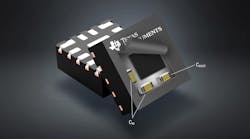This article is part of Electronic Design’s coverage of APEC 2022.
Power electronics that convert one voltage level to another are at the heart of many aspects of electric cars. To extend the driving range of electric cars, companies are trying to design smaller, lighter systems that can squeeze significantly electricity out of the car's batteries and do so more efficiently while releasing less heat.
But it can be a challenge to create power supplies with higher levels of efficiency and power density while limiting electromagnetic interference (EMI), which can lead to dangerous complications in electric vehicles. Analog chip giant Texas Instruments is trying to tackle these trade-offs with a new series of buck converters.
TI rolled out a new pair of synchronous step-down dc-dc converters—the industrial-grade LMQ66430 and automotive-grade LMQ66430-Q1—designed to reduce EMI on factory floors and in medical devices, autos, aerospace, and defense. The 36-V, 3-A buck converters combine two input bypass capacitors with a single boot capacitor in a compact 2.6- × 2.6-mm QFN package with wettable flanks, helping boost power density.
“We’re combining IP and in-package innovations,” Carsten Oppitz, VP and GM of buck switching regulators at TI, said in a briefing with reporters ahead of APEC 2022. The chips are also available in 2-A and 1-A variants.
“In today’s electric vehicles, you have so many more systems, and these systems are all very sensitive,” he said, including the high-voltage electronics and various power converters, all placed close together in the vehicle. There are also thousands of feet of cabling in electric vehicles, which can lead to large amounts of EMI. “We have to protect these systems from interfering with each other and it's really complex,” he added.
TI said the chips are suited for customers that need to meet strict EMI standards such as CISPR 25 Class-D.
Lower Inductance, Lower EMI
Bringing the passive components inside the package reduces the internal inductance of the device, TI said. That reduces the risk of overshooting when the dc-dc converter switches from one power level to another, which can cause more interference. The new chips integrate TI's proprietary on-die dual-random spread-spectrum (DRSS) technology to keep EMI in check over a range of frequency bands—both high and low.
TI said customers can adapt the frequency from 200 kHz to 2.2 MHz to avoid overly noisy frequency bands.
The new step-down power converters can handle a wide range of input voltages, from 2.7 to 36 V (after start-up or while operating), with the ability to withstand transients of up to 42 V. A buck converter is a widely used type of dc-dc converter that can convert or "step down" a high voltage from a power supply to lower levels used by a device. TI said its new components can convert input voltages to outputs of 1 to 35 V.
TI said the chips themselves run on very small amounts of power themselves, meaning they can be used for always-on industrial and automobile devices. The chips use 1.5-µA of quiescent current (IQ) at 13.5 V, which leads to more efficient power systems even when turned off or operating at lighter loads. The new devices, which can tolerate temperatures of –40 to 150°C, deliver more than 85% efficiency at a current of 1 mA.
Moving passive components from the circuit boards to inside a package promises to save extra space in a system and reduce the bill of materials (BOM). The LMQ66430-Q1 is AEC-Q100-qualified.
Package + Process + IC Design
TI executives said the company is leaning heavily on advances in packaging as well as process technology and IC design to push the envelope in power density and reduce EMI that can sap a system’s performance.
“TI is relatively unique in the industry in that we have the ability to develop our own process technology and packaging, and we also have circuit designers that build the products that you see on the market,” said Jeff Morroni, head of R&D for power management at Kilby Labs, TI’s corporate research and development arm. “Having the ability to do all these things under one roof” helps to differentiate its products, added Morroni.
“This means the sum of the parts [in our products] can be greater than the individual contributions,” he said.
Check out more articles and videos in Electronic Design’s coverage of APEC 2022.
